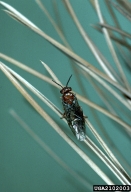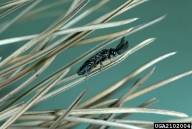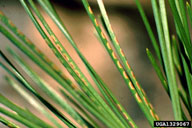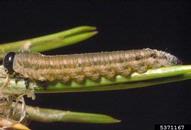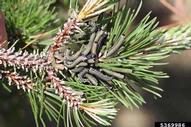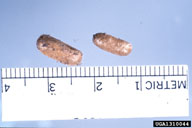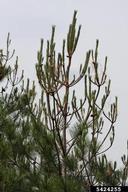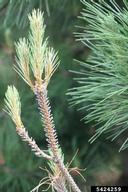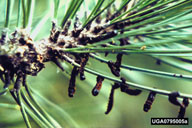European pine sawfly
Neodiprion sertifer (Geoffroy) (Hymenoptera: Diprionidae)
Orientation to pest
European pine sawfly, Neodiprion sertifer (Geoffroy), is a European species that is invasive in North America. It feeds on many species of pines. This sawfly occurs across Canada and widely in the eastern United States. The winter is passed as eggs, which hatch in early spring. Larvae feed gregariously on old needles. New foliage is never eaten. Larvae move from tree to tree as necessary for food. Mature larvae drop from foliage to the ground, where they spin a cocoon in the duff and pupate. Adults emerge in late summer and lay 6 to 8 eggs per needle in new foliage. There is one generation per year. Trees attacked by this sawfly are never killed because new foliage is not eaten. Damage consists of reduced tree growth in forests or loss of quality in Christmas tree plantations.
Hosts commonly attacked
European pine sawfly feeds on many species of pines, but especially on Scots (Pinus sylvestris L.), red (Pinus resinosa Sol. ex Aiton), jack (Pinus banksiana Lambert), Japanese red (Pinus densiflora Siebold & Zucc.), and Table mountain pines (Pinus pungens Lamb.). Other species of pines will also be defoliated if they grow near an outbreak of this sawfly.
Distribution
This sawfly is found in Newfoundland, Nova Scotia, New Brunswick, Ontario, Quebec and British Columbia in Canada and in the eastern United States from New England west to North Dakota, and south to Missouri.
Images of European pine sawfly
| Figure 1. Adults of European pine sawfly, Neodiprion sertifer; left, female; right, male (see enlarged antennae) | Figure 2. Egg scars of European pine sawfly in needles of Scots pine |
| Figure 3. Larvae of European pine sawfly | Figure 4. Pupal cocoons of European pine sawfly |
| Figure 5. Damage to red pine by European pine sawfly larvae; note that only old needles are eaten | Figure 6. Larvae of European pine sawfly killed by a virus (note the characteristic position, hanging head down) |
Important biological control agents related to this pest species
Important natural enemies of this sawfly include an imported European nuclear polyhedrosis virus that is used effectively as a biopesticide, and several European larval parasitoids, which have not provided control of this pest.
Web links for information on European pine sawfly
- Fact Sheet | Ohio State University Extension
- Fact Sheet | ForestPests.org | Vermont Division of Forestry
- Fact Sheet | Pennsylvania State University Extension
- Fact Sheet | Natural Resources Canada
Articles
- Finlayson, L. R. and T. Finlayson. 1958. Parasitism of the European Pine Sawfly, Neodiprion sertifer (Geoff.) (Hymenoptera: Diprionidae), in Southwestern Ontario. The Canadian Entomologist 90: 223-225. (viewable at http://pubs.esc-sec.ca/doi/abs/10.4039/Ent90223-4)
- Entwistle, P. F., H. F. Evans, K. A. Harrap, and J. S. Robertson. 1978. Field trials on the control of the pine sawfly, Neodiprion sertifer, using purified nuclear polyhedrosis virus. Technical Report, Unit of Invertebrate Virology, Natural Environment Research Council (UK), 62 pp.
- Gur'yanova, T. M. 1979. Significance of the diapause of the parasite Exenterus abruptorius (Ichneumonidae) in the dynamics of numbers of the red pine sawfly (Neodiprion sertifer). Zoologicheskii Zhurnal 58 (9): 1339-1349.
